Components of the FGT
Click HERE for PDF version of this page
Evaluation against measures requires an understanding of certain concepts specific to fisheries management. The preceding glossary (Appendix B) offers definitions for many terms used throughout the Fisheries Governance Tool (FGT) and below we provide some additional clarification and guidance on selected concepts
ACHIEVING MEASURES OF POLICY CONTENT AND POLICY PROCESS INDICATORS IN COMPONENT 1
Key Question: Does the fisheries policy provide the basis for rational and effective governance and management of the nation's domestic fisheries, and its orderly and legitimate participation in international fisheries?
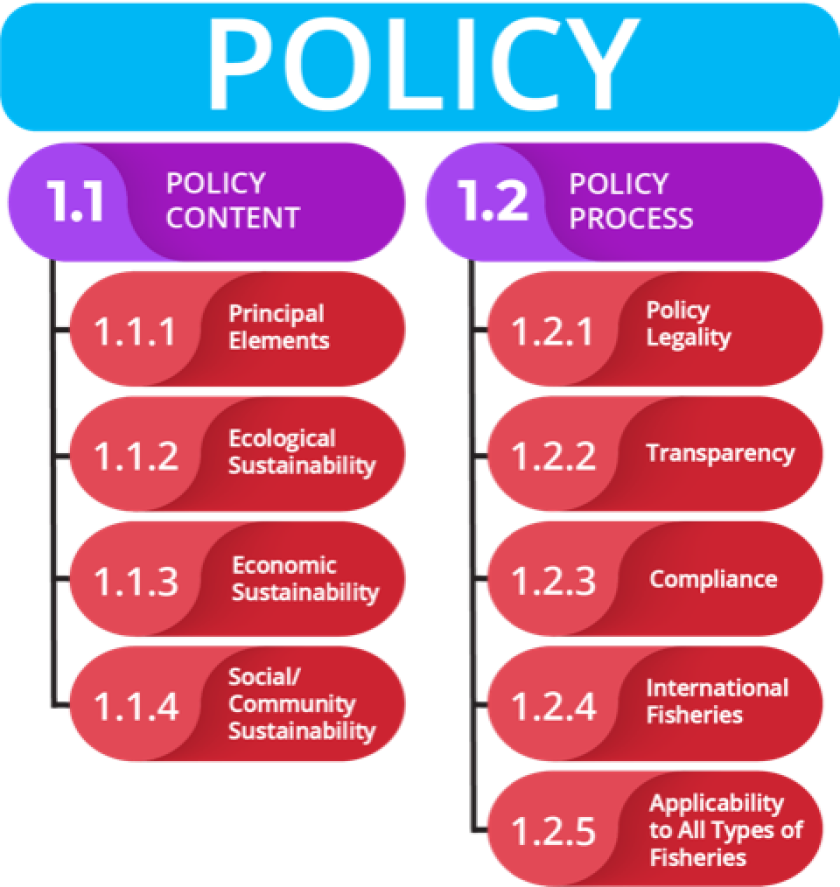
Policy contains big picture purpose - the "Why's" and Wherefores" - and the goals that governance capacity and management strategies are design to achieve. The policy should guide the management strategies but not be prescriptive, as the policy needs to provide the rules under which a diversity of fisheries can be managed towards common goals. Fishery laws, regulations, policy statements, or other overarching frameworks of fishery management systems contain objectives that will lead to achievement of the goals, strategies to achieve the objectives; and actions that result in outcomes that are measurable. These frameworks should include mechanism for measuring, and periodic evaluation/review/adaptation.
Fisheries management, as with the management of any natural resource, is a complicated process that occurs at a number of scales. Scientists and researchers may be primarily focused on the geobiophysical scale, while governance officials are primarily concerned with governance arrangements at different levels, which may or may not correspond directly to the scale of the resources being managed. Therefore, the user should define the governance system under evaluation, and be sure that the evidentiary information is appropriate to the scale of assessment.
The FGT can be applied to national, regional and/or local governance systems. The focus of the evaluation should be clearly defined, and measures should be assessed based on the scale of the evaluation. If evaluating across scales, evidence and justification should be documented for all. Where measures may not be applicable to a scale, they should be excluded from evaluation.
The following table provides examples of evidence needed to document whether indicator measures of policy content and process are met across differing scales of authority. Not all scales of governance are applicable to the system under evaluation, although national policy would apply to decision-making at all governance levels and would govern actions of citizens under the jurisdiction of the nation no matter where they are fishing. The indicators are measurable across the designated scales, and the measures throughout the FGT specify at which scale evidence is needed.

ACHIEVING MEASURES OF MANAGEMENT CAPACITY AND MONITORING, CONTROL, AND SURVEILLANCE INDICATORS IN COMPONENT 2
Key Question: Does the nation have the capacity to reliably and consistently implement the national fisheries policy in successful pursuit of the goals articulated therein?
Capacity provides a diagnostic of whether the management entity has the resources, tools, expertise, and authority to carry out the fisheries management mission described in the policy goals. Capacity must exist across scales, and where policy devolves authority to regions and states, there must be capacity at those levels to carry the management strategies forward. The FGT looks for information that demonstrates the fisheries system can engage and collaborate with public and private sector institutions, experts and decision-makers, as well as engage stakeholders in an inclusive and orderly process. Evidence of budget, personnel, scientific, monitoring, and enforcement capabilities provide documentation that the governance system can move beyond aspirational policy goals and carry out its mission.
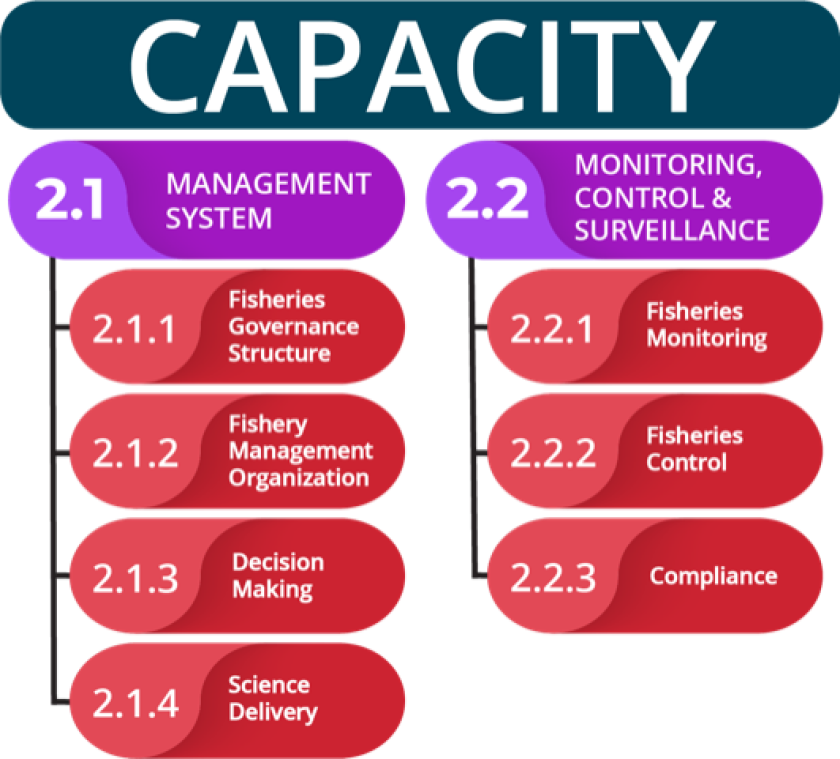
The following table provides examples of evidence needed to document capacity in governance, implementation, decision-making, science, and compliance at relevant scales of authority. Not all scales of governance may be applicable to the system under evaluation. For example, RFMO requirements for VMS might not apply to a coastal fishery within a nation's EEZ if that area was not within the RFMO's area of competence. The indicators are measurable across the designated scales, and the measures throughout the FGT specify at which scale evidence is needed.
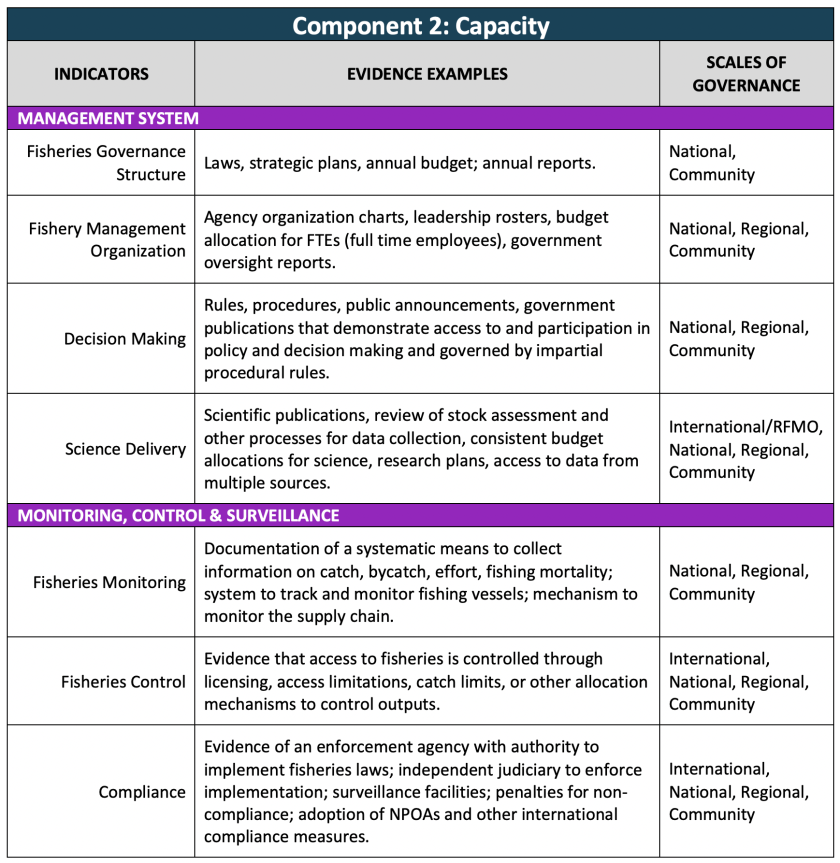
ACHIEVING MEASURES OF PRINCIPAL ELEMENTS, ECOLOGICAL SUSTAINABILITY, ECONOMIC SUSTAINABILITY, AND SOCIAL/COMMUNITY INDICATORS IN COMPONENT 3
Key Question: Does fisheries management function in a way that effectively and efficiently implements the fisheries policy?
In order to achieve fishery-specific goals and objectives, fishery-specific management should fit within the structure established by the overarching requirements described in Component 1. They should also match the capacity identified in Component 2 to successfully implement management. Component 3 evaluates how the fishery-specific management implements policy to the unique features of the fisheries - and where those measures achieve desired outcomes. Often, such conversion of policy to management occurs in Fishery Management Plans (FMP) and may focus on a single species/stock, may contain a suite of similar species, or may be regional in their focus to address activities in a defined area.
In establishing fishery-specific management measures, decision-making should consider relevant conservation issues, user conflicts, fishery access and rights, the potential impacts of the fishery on species, habitats and ecosystems, social and economic impacts, and cumulative effects, among others. Effective measures account for impacts across ecological, economic, and social well-being while recognizing the potential for conflict and providing mechanisms for trade-offs. All the factors challenge the ability of fishery-specific management systems to deliver on their designated goals and objectives.
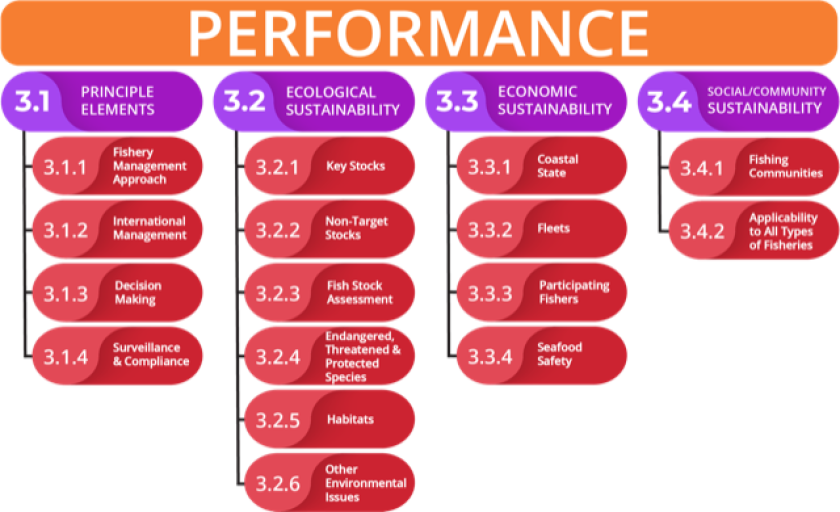
The following table provides examples of evidence needed to document performance at the fishery level across the triple bottom line of sustainability. Performance outcomes are measured at the most meaningful scale, such as fishery, stock, ecosystem, country-wide, or community level. The indicators are measurable across the designated scales, and the measures throughout the FGT specify at which scale evidence is needed. Given Component 3 is measuring performance across a collection of specific fisheries, most decision making and implementation will not be at the national level. However, there are instances where regulatory requirements are national, though implemented regionally and locally.
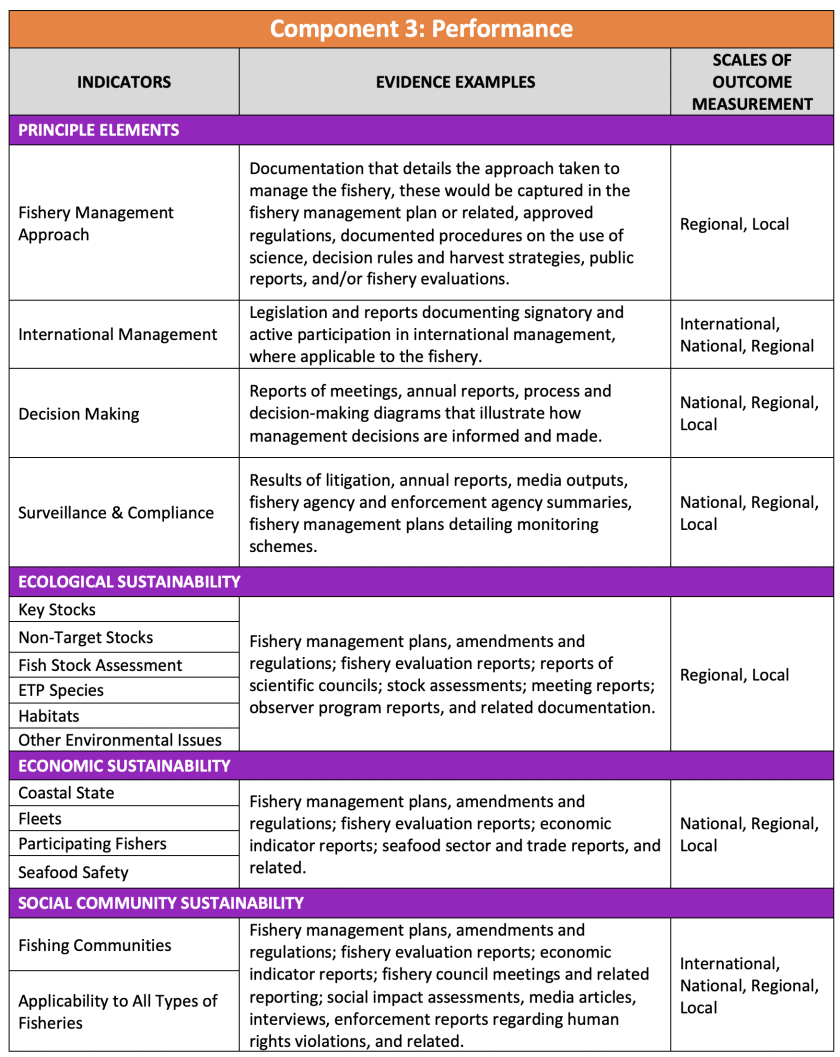
ADDITIONAL GUIDANCE
Best Scientific Evidence Available
The "best scientific evidence available" should form the basis for sound resource management decision making. The requirement for best scientific evidence is in measure 1.1.1.4 but is built on through increasing requirements in the identification of the precautionary approach use of science in decision making, implementation of policy in achievement of goals, data collection, stock assessments and management strategies. "Best scientific evidence available" has been established by UNCLOS (United Nations Convention on the Law of the Sea) as the basis for decision-making in fisheries management, including for the application of the precautionary approach.
What is actually the best scientific evidence available in any given fishery or for any given stock under consideration will vary between fisheries and stocks and will also vary over time as information levels fluctuate. What is important, therefore, is that the management system is designed in such a way that the mechanism by which it commissions science and solicits scientific advice results in it receiving the best scientific evidence available. Achieving the best scientific evidence available requires inter alia:
- questions to be clearly stated,
- scientific investigation to be well designed, and
- results to be analyzed logically, documented clearly, and subjected to peer review.
Even science that has been developed through an open, transparent, and well-communicated process may not be fully adequate for addressing management issues. Scientists must often rely on incomplete information in offering their best expert advice.
According to the FAO, the "best scientific evidence available" can include traditional, fisher, or community knowledge, provided its validity can be objectively verified. Objective verification of validity implies that the knowledge has been collected and analyzed though a systematic, objective and well-designed process, and is not simply hearsay. Publication of results in the peer-reviewed literature could be one form of objective verification.
Implementation of best scientific evidence available:
To adequately implement the best available science, it is essential that policymakers clearly articulate the purpose of regulations and laws, clearly specify who is responsible for interpreting and enforcing them, endeavor to identify and reduce conflicts of interest, and recognize differences in the knowledge base and values of scientists, managers, and other stakeholders (Sullivan et. al. (2006)).
Improving the Use of the “Best Scientific Information Available” Standard (NRC, 2004):
Science is a dynamic process, and new scientific findings constantly advance the state of knowledge. Best scientific information is, therefore, not static and ideally entails developing and following a research plan with the following elements: Clear statement of objectives; conceptual model that provides the framework for interpreting results, making predictions, or testing hypotheses; study design with an explicit and standardized method of collecting data; documentation of methods, results, and conclusions; peer review, as appropriate; and communication of findings. Criteria to consider when evaluating best scientific information are relevance, inclusiveness, objectivity, transparency and openness, timeliness, verification and validation, and peer review, as appropriate.
- Relevance: Scientific information should be pertinent to the current questions or issues under consideration and should be representative of the fishery being managed. In addition to the information collected directly about the fishery being managed, relevant information may be available about the same species in other areas, or about related species. For example, use of proxies may be necessary in data poor situations. Analysis of related stocks or species may be a useful tool for inferring the likely traits of stocks for which stock-specific data are unavailable or are not sufficient to produce reliable estimates. Also, if management measures similar to those being considered have been introduced in other regions and resulted in particular behavioral responses from participants or business decisions from industry, such social and economic information may be relevant.
- Inclusiveness: Three aspects of inclusiveness should be considered when developing and evaluating best scientific information:
- The relevant range of scientific disciplines should be consulted to encompass the scope of potential impacts of the management decision.
- Alternative scientific points of view should be acknowledged and addressed openly when there is a diversity of scientific thought.
- Relevant local and traditional knowledge (e.g., fishermen's empirical knowledge about the behavior and distribution of fish stocks) should be obtained, where appropriate, and considered when evaluating the BSIA.
- Objectivity: Scientific information should be accurate, with a known degree of precision, without addressable bias, and presented in an accurate, clear, complete, and balanced manner. Scientific processes should be free of undue nonscientific influences and considerations.
- Transparency and openness: There should be broad public and stakeholder access to the fishery conservation and management process, including access to the scientific information upon which the process and management measures are based. Public comment should be solicited at appropriate times during the review of scientific information. Communication with the public should be structured to foster understanding of the scientific process.
Precautionary Approach to Fisheries Management (FAO 1995, 1996)
Precautionary Approach to Fisheries Management (FAO 1995, 1996) The precautionary approach involves the application of prudent foresight, taking account of the uncertainties in fisheries systems and the need to take action with incomplete knowledge. The UN Fish Stocks Agreement (1995), Article 6 states: The precautionary approach shall be interpreted to mean being cautious when information is uncertain, unreliable or inadequate and that the absence of adequate scientific information shall not be used as a reason for postponing or failing to take conservation and management measures. It requires, inter alia:
- consideration of the needs of future generations and avoidance of changes that are not potentially reversible;
- prior identification of undesirable outcomes and of measures that will avoid them or correct them promptly;
- that any necessary corrective measures are initiated without delay, and that they should achieve their purpose promptly, on a timescale not exceeding two or three decades;
- that where the likely impact of resource use is uncertain, priority should be given to conserving the productive capacity of the resource;
- that harvesting and processing capacity should be commensurate with estimated sustainable levels of resource, and that increases in capacity should be further contained when resource productivity is highly uncertain;
- all fishing activities must have prior management authorization and be subject to periodic review;
- an established legal and institutional framework for fishery management, within which management plans that implement the above points are instituted for each fishery, and
- appropriate placement of the burden of proof by adhering to the requirements above (FAO, 1996, para 6).
Other Issues
Fishery evaluations may require considerations of issues such as small scale fisheries
(http://www.fao.org/fishery/ssf/en), data poor fisheries (https://www.nrdc.org/sites/default/files/improving-data-limited-fisheries-report.pdf), and low tropic level fisheries (https://www.pewtrusts.org/~/media/assets/2015/03/turning_the_tide_report.pdf. It is not practical to identify and describe all such issues here. However, application of best available science and the precautionary approach, combined with finding and using guidance developed for these fisheries, will allow use of this FGT for other issues that may arise.